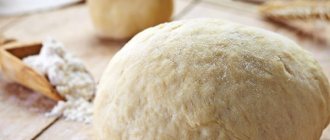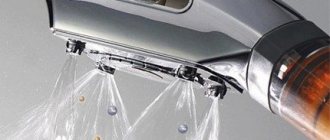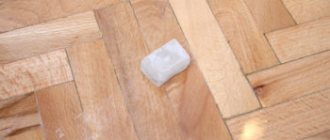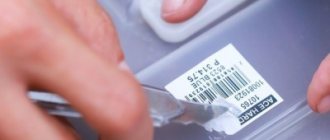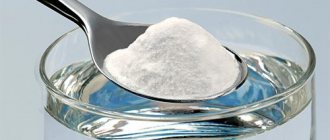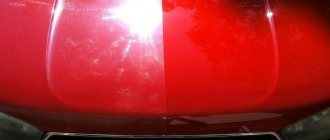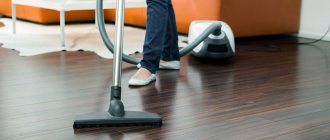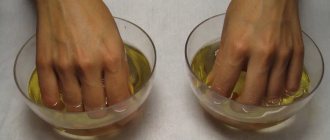Repair is a rather labor-intensive process, requiring not only physical effort, but also moral effort. However, it is possible to see and appreciate all the beauty of the work done only after cleaning the porcelain tiles.
Porcelain stoneware is a fairly durable and wear-resistant material; use for many years will not change its appearance. But after construction and finishing work, various types of pollution may remain. Let's look at how to wash porcelain tiles and how to clean them correctly, depending on the situation.
Types of contamination after repair
Surfaces lined with porcelain stoneware are very resistant to any adverse influences. The tile does not absorb dirt, is not afraid of temperature changes, does not collapse or lose its color under the influence of moisture, and is highly resistant to wear.
Nevertheless, porcelain tile cladding must be protected from exposure to abrasive particles, and maintenance should be carried out from time to time to maintain the surface in perfect condition.
So, what exactly can leave marks on porcelain stoneware:
- dye;
- glue;
- primer;
- putty;
- sealant;
- grout.
If you have time to wash the porcelain stoneware surface immediately after any of the above gets on it, then no special efforts or special compounds will be required. A wet wipe will do the job quite well.
In cases where the stains have already dried, the cleaning process becomes a little more complicated; specialized detergents are needed; with their help, you can clean porcelain stoneware quite easily.
Advice. Before you start using an aggressive cleaner, you need to test its safety on a small piece of tile in an inconspicuous place.
How and with what to wash primer from porcelain tiles
If porcelain tiles are stained with a primer, and unpleasant whitish stains remain, then you can clean it with household chemicals that contain acid.
If stains appear again after drying, then you need to apply a bathroom cleaner, cover with a wet cloth and let it soak for an hour, then thoroughly rub the stain with a stiff brush or washcloth, then rinse with clean water and quickly wipe the stain dry.
We suggest you read: Do I need to clean the boiler?
You can easily and quickly wash the primer from porcelain stoneware using available detergents.
The ingrained, dried primer is difficult to wipe off from porcelain stoneware; it is recommended that when repairs are carried out, the following precautions are taken:
- Cover porcelain tiles with plastic film or other protective material;
- Wipe off dirt as soon as it appears, do not allow it to soak in and dry out.
- If the tile surface is unpolished or semi-polished, special protection is required.
It is necessary to apply the preparation to the porcelain tiles, rub it over the surface with a hard sponge, and then rinse with clean water. Be careful with your ceramic tiles, and then you won’t have to wash them with all sorts of chemicals.
Methods for cleaning porcelain tiles after repair
- Cement grout, plaster - easily washed off with water.
- Epoxy grout - can only be removed using a special epoxy solvent.
- Hardened glue - soaked in a solution of vinegar or premium acetone, then removed mechanically using a spatula, knife, or scraper.
- Dried paint - removed using a solvent suitable for this type of paint, first the stain is soaked, then rubbed and removed.
- Water-based paint - easily washed off with water.
- Absorbed primer is soaked with solvent or acetone, then removed mechanically.
Advice. To easily clean the tiles, you need to correctly determine the type of contamination and apply the appropriate product. However, the best way is to protect the surface before starting repair work - it can be covered with plastic film.
Cleaning stains from porcelain tiles
To remove stains from porcelain tiles, you need to understand what substance caused the stain. For each case there is a special drug.
If stains are left by tea and coffee, as well as fruit juice, then it is best to remove them with a soda solution. Dried stains, as well as traces of wine and oil, can be easily removed with alkaline solutions or bleach.
Paint stuck to the tiles can be removed with gasoline or acetone. The same method is suitable for cleaning porcelain tiles from traces of glue and rubber.
Acid-containing preparations effectively remove stains from porcelain stoneware caused by splashes from plaster, putty and other mixtures. Before removing them, it is recommended to seal the seams between the tiles with tape to prevent the acid from damaging the grout.
With proper and careful care, porcelain tiles will last a long time, retaining all their advantages. It is enough to remember the above recommendations and apply them in practice.
Cleaning porcelain tiles with improvised means
Polished porcelain tiles should be washed using special formulations that do not contain powders or abrasive components. Otherwise, the glossy effect will disappear and it will have to be polished again.
In this regard, matte porcelain tiles are more unpretentious. It can be cleaned with powders without fear of the surface becoming dull or scratched. The use of abrasive cleaners on matte tiles is permitted, although not recommended.
Porcelain tile is quite resistant to the effects of aggressive chemicals, but still you should not abuse it; it is better to first try to wash it with improvised means at home.
After cutting and laying porcelain tiles, having eliminated all the resulting dirt and dust residues, it is necessary to wash them with a soapy solution. To add shine, you can wipe it again, but with clean water with the addition of ammonia, vinegar or citric acid.
How else can you clean porcelain tiles:
- Windshield cleaner - wet the stain and let it sit;
- Table salt - applied to dirt and moistened;
- Tooth powder - moistened with water and applied to the stain, then removed with a stiff brush;
- Liquid for cleaning bathrooms - applied to stains in several layers.
All these methods are quite effective and do not harm the tile surface.
How to effectively clean rough porcelain tiles
Sporo AH-737 is an effective means for cleaning rough and embossed tiles.
It is easiest to remove excess and residues of building mixtures that have fallen on the tiles from a smooth surface.
Difficulties arise when scrubbing tiles that have a textured, rough, embossed or decorated outer surface.
Contamination must be removed immediately, without allowing it to completely harden. If this does happen, to effectively clean rough porcelain tiles, you can use the wet method or use a professional cleaner for cleaning tiles after renovation, for example, Sporo AH-737 .
To clean, you need to apply the cleaner to the stained surface. Then use a foam sponge or soft bristle brush to remove dirt using gentle circular movements.
The use of abrasives, aggressive chemicals, and powdered products that can damage the coating of textured tiles is not recommended. To eliminate white deposits, you can use gel detergents.
When choosing a cleaning method and chemical compositions, it is necessary to take into account the properties of the facing material and the type of contamination.
Protection of porcelain tile floors
If the room is being renovated, the porcelain stoneware floors must be covered with protective materials. Otherwise, a dropped tool or other heavy object can split the tile and leave permanent scratches and chips on it.
It is enough to lay cardboard sheets from household appliances or, at worst, plastic film. Repairs are always accompanied by dirt and dust, so the film will protect the tiles from scratches left by particles of sand and concrete chips.
Porcelain floor tiles require protection from street dirt, which is brought into the room along with shoes. Owners of such floors should use rugs at the entrance to the house and warn guests not to walk on the tiles with boots.
If a floor lined with porcelain stoneware becomes dirty, this is not a problem for the tile itself. In this case, the tile joints suffer more, especially if they are made of cement-based grout.
The penetration of acids into these places leads to the destruction of the cement binder, resulting in a deterioration in the decorative qualities of the cladding. Therefore, during the operation of such surfaces, dirt should be removed from the tile joints in a timely manner and aggressive liquids should not be allowed to enter.
Protecting glossy tiles
Porcelain tiles with a glossy surface are most vulnerable to damage. You need to take care of its condition immediately after finishing the facing work.
First of all, the tiles are treated with wax or other compounds that create a dirt-proof and moisture-repellent film.
This film gradually deteriorates, so treatment should be carried out once a month. In the absence of additional protection, glossy tiles will fade, become dirty and lose their former attractiveness.
Restoring its original appearance will be much more expensive and difficult compared to periodic waxing.
Glossy tiles should not be used as flooring in damp rooms or near entrance doors. This is due to the fact that the smooth polished surface becomes very slippery when water gets on it.
What should be the cleaning product for cleaning ceramic tile floors?
We figured out the pH value of the ceramic floor tile cleaner. But the percentage of acid or alkali in the solution is not the only parameter of choice.
Signs of a good tile floor cleaner:
► When mixed with water, the concentrate does not form a foam cap. Low-foam products contain defoamers, and the surfactant content does not exceed 5%.
► The product contains no abrasive particles that can scratch the surface of the floor covering.
► The ceramic tile cleaning product contains components that protect the seams and surface of the tile from contamination (refers to specialized cleaners). Additional care is provided by waxes, enzymes, and water-based fluorocarbon polymer.
| Special products for cleaning tiles and porcelain stoneware | Emsal Floor Care, Glutoclean, Prosept Multipower, HG, Mellerud for tiles and stones, Kiilto Clean |
| Universal floor cleaners | Pronto, Sanfor, Unicum, Sarma, Help |
| Weak acidic agents for removing limescale from tiles | Comet Expert against plaque and rust, Zero spray for removing plaque, Cillit Brilliant, Gloss Anti-Plaque, Sanox “Clean Bath”, Unicum spray, any gels and sprays for cleaning acrylic bathtubs |
| Weakly alkaline products for removing grease from tiles | Amway for the kitchen, Homestar 10 in 1, Meine Liebe Anti-grease, Frosh Grapefruit |
Please note: we do not recommend washing glossy tile or porcelain tile floors with a soapy solution made from laundry soap shavings or liquid hand/dishwashing detergent. After this procedure, the surface will lose its original shine and become covered with cloudy stains.
Read the blog:
Care Tips
In order for the porcelain stoneware floor or walls to remain in excellent condition for as long as possible, certain care rules must be followed:
- periodically treat the surface with wax-based compounds;
- annually use a special product designed to protect porcelain stoneware;
- to add shine, wash with lemon juice or vinegar solution;
- You can polish the glossy surface with a piece of felt cloth;
- unpolished porcelain tiles with a rough surface are cleaned using a steam generator, followed by treatment with a dry rag. It is better to clean immediately after contamination occurs.
- To ensure that there are no streaks left after washing porcelain tiles, it is enough to use glass cleaning products that contain alcohol.
To summarize, it can be noted that any contamination of porcelain stoneware is best removed without delay. But if you don’t have time, specialized products that can clean the surface of stains of any complexity will help.
Why do divorces occur?
In order to carry out quality cleaning, it is important to know the reason for the appearance of certain defects.
The most acute problem is the appearance of stains on the surface even after thorough cleaning. Why does this happen? Let's look at the possible reasons:
- Unwashed dirt. A standard problem is when, when the tile is heavily clogged, dust particles are spread across the surface and it becomes very difficult to completely clean the tiles.
- Dirty water. During cleaning, you need to change the water as often as possible, as it contains dirt particles.
- Hard water. The problem of whitish stains and deposits is mainly associated with the high salt content in tap water.
- Unwashed product. Some cleaning products may remain on the surface of the tiles after washing them. Unless otherwise specified in the instructions, it must be washed clean.
- Dirty rag. In case of heavy contamination, it is recommended to rinse the cloth frequently under running water to remove dust particles.
Types of stains on tiles in the bathroom
Divorces can be of different types. The most common problems are:
- dirty stains;
- limescale;
- traces of detergents;
- greasy stains.
To cope with these problems, you need to select acidic media. They perfectly destroy dirt and at the same time give the tiles a glossy shine.

